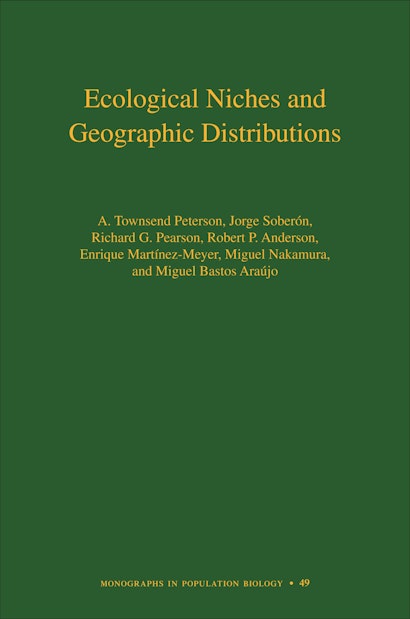This book provides a first synthetic view of an emerging area of ecology and biogeography, linking individual- and population-level processes to geographic distributions and biodiversity patterns. Problems in evolutionary ecology, macroecology, and biogeography are illuminated by this integrative view. The book focuses on correlative approaches known as ecological niche modeling, species distribution modeling, or habitat suitability modeling, which use associations between known occurrences of species and environmental variables to identify environmental conditions under which populations can be maintained. The spatial distribution of environments suitable for the species can then be estimated: a potential distribution for the species. This approach has broad applicability to ecology, evolution, biogeography, and conservation biology, as well as to understanding the geographic potential of invasive species and infectious diseases, and the biological implications of climate change.
The authors lay out conceptual foundations and general principles for understanding and interpreting species distributions with respect to geography and environment. Focus is on development of niche models. While serving as a guide for students and researchers, the book also provides a theoretical framework to support future progress in the field.
A. Townsend Peterson and Jorge Soberón are professors of ecology and evolutionary biology at the University of Kansas. Richard G. Pearson is a scientist at the American Museum of Natural History. Robert P. Anderson is associate professor of biology at the City College of New York, CUNY. Enrique Martínez-Meyer is professor at the Universidad Nacional Autónoma de México. Miguel Nakamura is a researcher at the Centro de Investigación en Matemáticas in Guanajuato, Mexico. Miguel B. Araújo is a senior researcher at the Museo Nacional de Ciencias Naturales in Madrid, and at the Universidade de Évora, Portugal.
"[Ecological Niches and Geographic Distributions] would serve as an excellent and authoritative textbook or resource for an upper-level undergraduate or graduate-level class on ecological modeling."—Choice
"This book is an impressively well written exposition of the conceptual foundation, practical implementation, and potential applications of niche modeling. . . . Overall, this book is an instant classic and a critical read for anyone interested in this fast-moving field of ecological niche modeling. I have already assigned it as required reading to graduate students in my lab."—Alycia Stigall, Priscum
"I found this book very useful. Its theoretical rigor will please those already involved with niche modeling, and its numerous and interesting examples make it accessible to a broad readership."—Ian S. Pearce, Quarterly Review of Biology
"Ecological Niches And Geographic Distributions concisely summarizes the conceptual framework and current major issues in a diverse and rapidly expanding literature. The numerous illustrations help to clarify key concepts and case studies, and the writing is clear throughout. Although the book sometimes forgoes depth in favor of clarity, ultimately I feel that this approach is for the best; many of the chapters in Parts 2 and 3 could be expanded to fill entire books of their own, but doing so would necessarily sacrifice much of the 'big picture' that is the focus of this volume. Ecological niches and geographic distributions would be a worthy addition to the library of any investigator using ENM/SDM methods in their research, and would be an excellent resource for students and investigators who are encountering the field for the first time."—Dan L. Warren, Ecology
"With a real exploration of key concepts, this book will be an essential guide for students and researchers, providing a theoretical framework with which to support future progress in the field. This book is highly recommended."—Evelyne Bremond-Hoslet, National d'Histoire Naturelle
"The seven authors have merged their ideas seamlessly."—Janet Sprent, Bulletin of the British Ecology Society
"A valuable and timely synthetic overview, this volume does a particularly nice job of laying out the conceptual challenges and technical subtleties that need to be considered in order to develop rigorous, niche-based models of species' distributions, and then of illustrating these issues with a wide range of applications. I warmly recommend this book to a broad range of readers."—Robert D. Holt, University of Florida
"When it comes to explaining the theory and practice of niche modeling and species distribution modeling, this is the right book at the right time by the right authors. The book provides a vigorous exploration of a key concept—the ecological niche—and an equally vigorous discussion of approaches to model niches. Essential reading for novice and expert alike."—Robert Guralnick, University of Colorado Boulder

